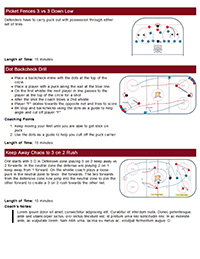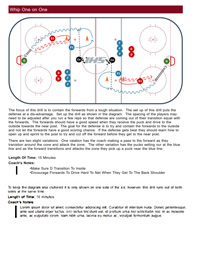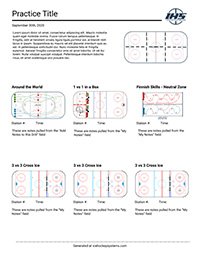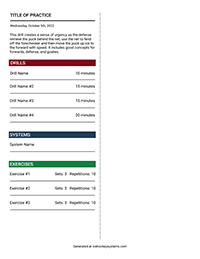Jr / College / Pro Battle Day Example Practice
Jr / College / Pro Battle Day Example Practice
Please Note: This Jr / College / Pro Battle Practice Example is designed to be utilized across multiple age levels. With that being said, we encourage you to adjust the drills & games based on your team's age and skill levels. These drills and practices can be modified to become more basic or more advanced.
Practice Setup:
- Divide up teams evenly (2 color jerseys)
- Tally up the points scored in each game. The team with the most points at the end of a game is awarded 1 point.
- Depending on the amount of ice-time you have, you can play 3 to 7 games.
- Below we show examples of 7 games that can be used, with links to view 150+ other games.
Coaching Points:
- Have fun!
- Encourage teammates to communicate, and cheer for each other throughout the practice!
- Each drill and game will have different constraints that may work on different concepts & skills, let players know of the the concepts & skills they should focus on to be successful in each game.
- Coaches can view our 8 Hockey Habits webinar to get ideas on general habits that should be reinforced throughout the whole practice.
Battle Day Practice Overview
Protect The Puck Warm-Up (Individual & Team)
This is a fun dynamic warm-up that helps coaches jump-start practice with a competitive puck protection exercise, followed by a competitive team puck possession exercise. Depending on the age and skill level of your players, coaches can modify this drill to make it easier by adding more pucks, or reducing the number of players involved. Scroll to the bottom of this description and you can view examples of how to make these exercises a game (which makes it very fun for younger players).
Setup
Part # 1: Individual Puck Protection
- Split up your team into two groups. If you have full ice, each group can play in their own offensive zone. If you have half ice, one larger group can play in the zone, and the second group can play in the neutral zone.
- On the whistle, a coach chips in a limited number of pucks for players to battle over. In the video, there were 3 pucks used for 10 players. Coaches can add more pucks to make it easier for the players or for younger age groups. Play this out for a minute or so before you switch to a second group or move to Part # 2 of the drill.
Part # 2: Team Keep Away
- The coach combines the groups so there are now two teams playing inside one zone.
- On the whistle, the coach chips in a limited number of pucks for players to battle over. In the video, there were 2 pucks used for the two teams.
Variations
- Make it easier: add more pucks or reduce the number of players.
- Ice space: Can set this up in different areas of the ice.
- Players: Can use your whole team at once or split up into groups so players get a rest.
- Gamify: Can make drill into a very fun competitive game by playing Finders Keepers (players are knocked out of each round if they do not have a puck when time is called) and Finders Keepers With Teams (the team with the most pucks at the end when time is called wins).
Coaching Points
- Part #1:
- If you have the puck, work to protect it with your body and by keeping your head up so you can skate to space, or cut back to create space.
- If you do not have the puck, keep your stick on the ice and compete to get the puck back.
- Part # 2:
- If your team has the puck, keep your head up so you can utilize give & gos!
- If your team does not have the puck, keep your stick on the ice to take away passing lanes and compete to get the puck back.
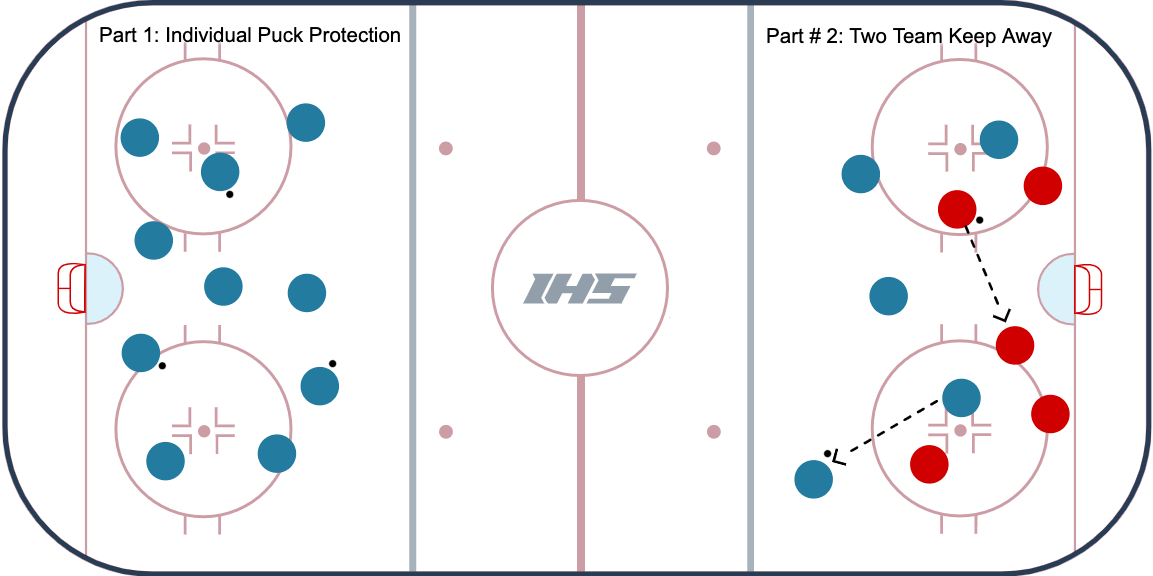
This is a warm-up activity. No points will be scored here.
Triangle Scoring Game
Description
The Triangle Scoring game from Kendall Coyne Schofield is a race to score first and involves moving the puck quickly and using deception with your passes and shots. It's a great game to work on quick power play puck movement and for the defensemen/penalty killers to work on pressuring and having their stick in the proper lane.
Set Up
- 2 Nets should be set up on the goal line in an offensive zone in line with the face-off dots
- Draw a triangle from the goal line to the top of the circle - if you don't have a marker use a few cones/tires (they can act as an additional constraint for the team trying to score)
- 1 goalie in each net
- 1 puck per triangle (on the outside)
- 3 players on team "X" on the outside of the triangle
- 1 player from team "O" on the inside of the triangle
- Set up the other triangle with the opposite set of players - 3 "O"'s on the outside and 1 "X" in the middle
- Coach should be ready with a pile of pucks up top
Game
The objective of this game is for the players on the outside of the triangle to score before the opposing team does. Each goal counts as a point and the game can go up to a certain number, with team "X" playing against team "O"
- On the whistle the game starts
- The players on the outside of the triangle are stationary, but can pass the puck through the triangle
- The objective of the players on the outside of the triangle is to score before the outside players of the opposing triangle score
- It's a race to see which team can score first
- The player on the inside of the triangle can move anywhere throughout the triangle, but not leave it
- The objective of the inside player is to clear the puck out of the triangle
- Whichever team scores first is awarded a point
- As soon as 1 side scores, the whistle blows and the next set of players moves in for each triangle
- Keep Score!
Variations
- Coaches can award a point to the team when a player on the inside of the triangle clears the puck
- Coaches can make clearing the puck and scoring different point values
- You can require one or two-touch passing/shooting
- Can allow players to skate through the triangle
- Can use the face-off circles instead of a triangle (see the Circle Scoring Game)
Coaching Points
- Use Deception - deception can be used by using your eyes and body language to be deceptive with passing and shooting to throw off the defender and/or goaltender
- Quick Release - to be successful, this game requires quick puck movement and quick releases when scoring opportunities present themselves
- Active Stick - the player in the triangle needs to have a very active stick as the puck moves around and through the triangle
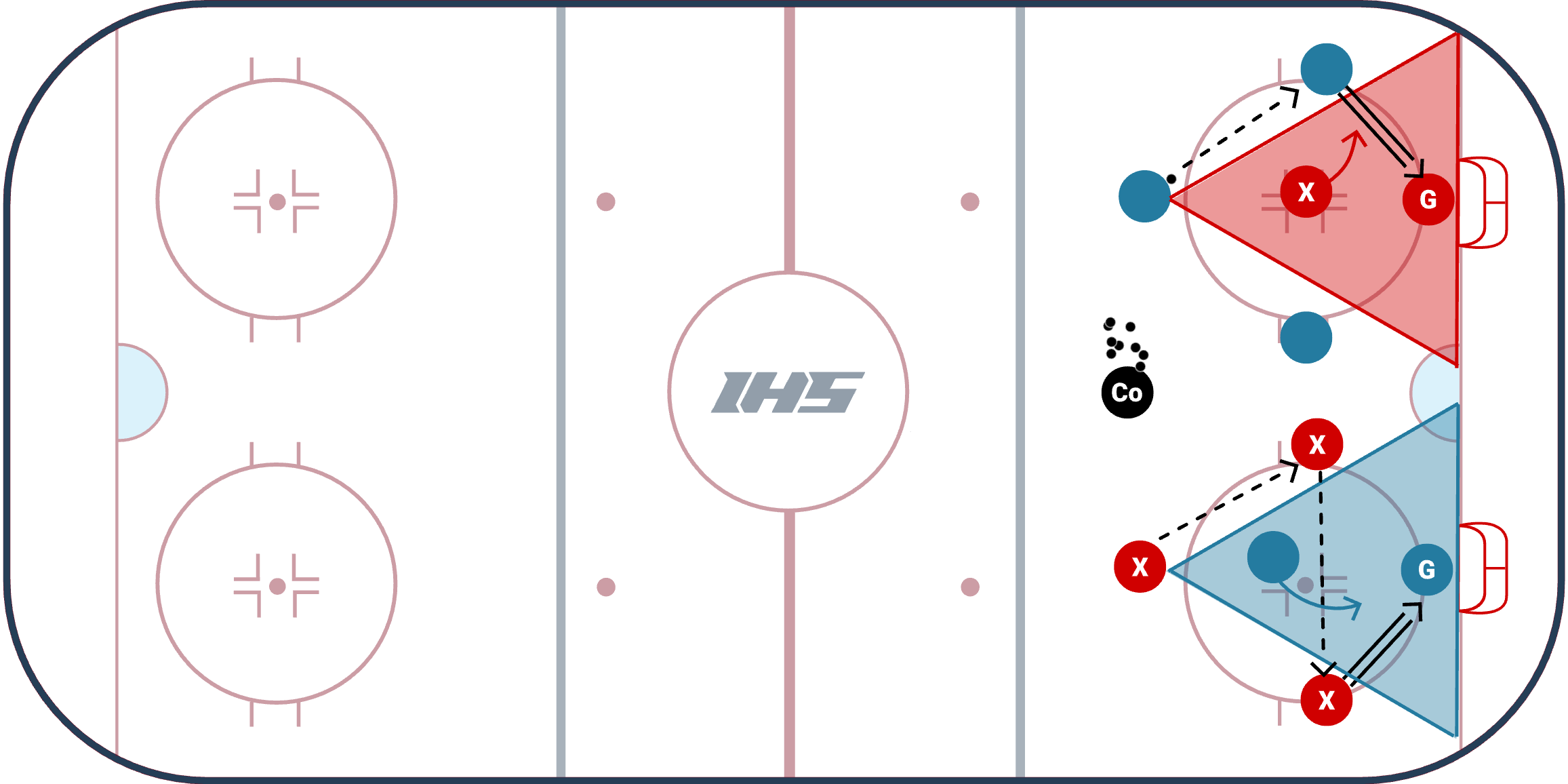
2 v 2 Bagger
Description
This small area game from Kendall Coyne Schofield requires a lot of decisions, thinking and working no matter which side of the puck you are on. It is great for working hard to get to open space and utilizing your support players to create opportunities on offense. The game reinforces all of the key themes that Kendall looks to get out of small area games including; moving, thinking, working, creativity, decision making and fun.
Setup
- 2 Nets should be set up on the goal line in an offensive zone in line with the face-off circles
- Each team is designated a net for them to score on and another to defend
- Teams consist of 2 active players and 2 stationary players
- Players not participating can line up on the blue line and keep the puck in
- The 2 active players per team can go anywhere in the zone
- The 2 stationary players per team are lined up at the point and along the boards just above the hash mark
- Coaches set up just outside of the blue line with pucks
Game
Objective: Play a game up to a certain number team "X" vs team "O"
- Coach dumps 1 puck in and the players play 2 v 2 in the zone to try to score on the opponents net
- The active players can use their stationary support players who can either pass or shoot to score
- The coach allows players to compete as long as he or she sees fit (usually 30-40 seconds)
- Each goal counts towards the team total
- When the whistle blows or a goal is scored, the active players leave the zone to rest, the stationary players become the active players and 2 new stationary players come in
- Coach can throw in a new puck when:
- The goalie covers the puck
- The puck goes out of play
- A goal is scored
Coaching Points
- Working hard to get open and find lanes
- Identifying and using outlets for support to relieve pressure
- Communication: practicing both verbal and non-verbal communication with your teammates
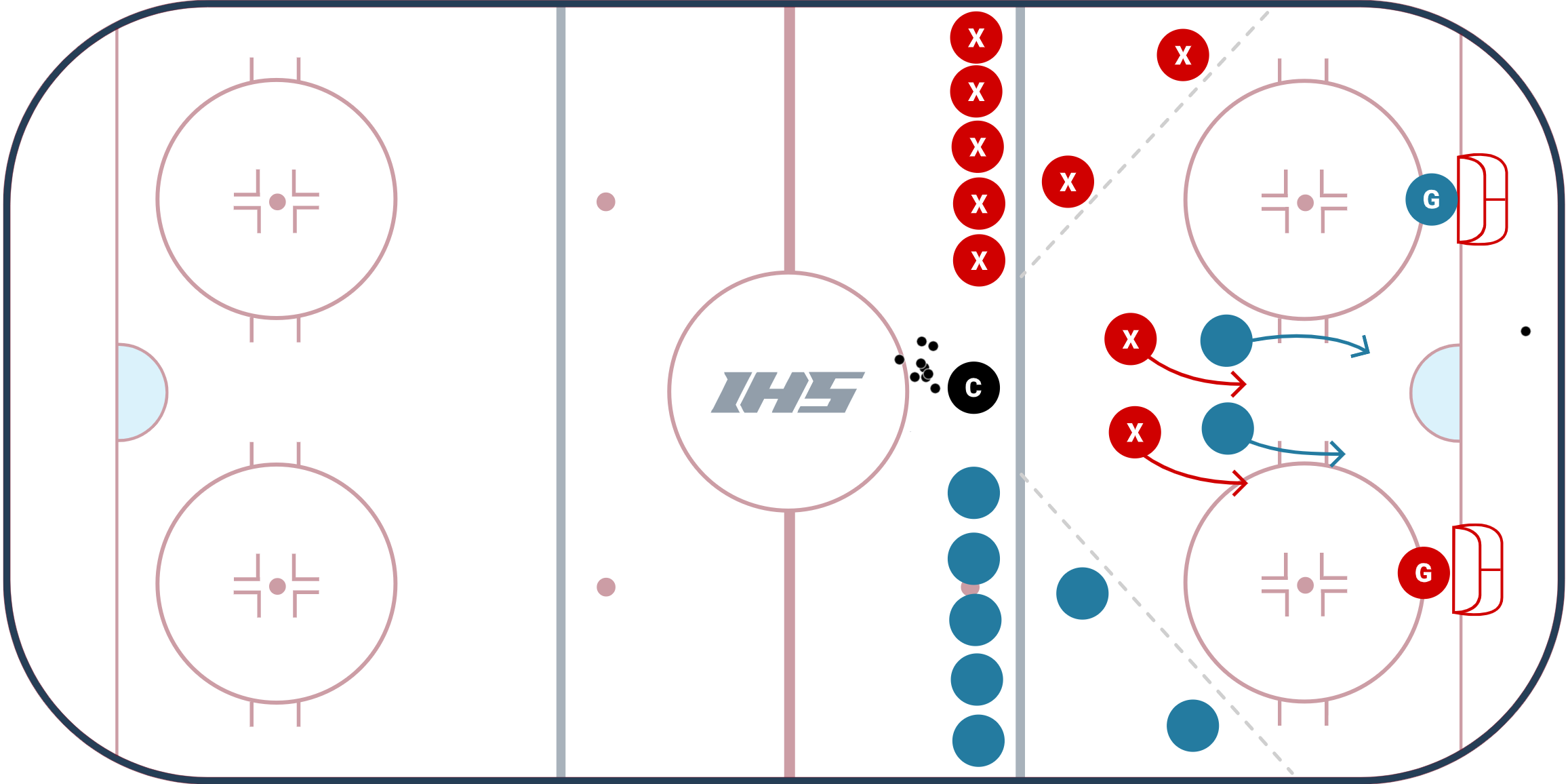
4 V 2 Two Touch Game
The 4 V 2 Two Touch Game from TJ Manastersky is fun game that brings energy and enthusiasm to your practice. It also works on your Power Play and Penalty Kill concepts. There is one major constraint to the game, players can only touch the puck twice before they move it. If a player breaks the rule and touches the puck more than twice, they are required to skate all the way around the ice while the game continues.
TJ Manastersky shared this game with the IHS Community while he was an Assistant Coach at Union College. TJ is the Current Head Coach at Brock University in St. Catharines, Ontario.
Setup
- Back to back nets in one of the zones.
- There is a 4 on 2 on each side of the net.
- The 4 forwards are trying to score by only two touch passing & shooting, while the defenders are trying to take the puck away and make a two touch pass to their 4 forwards in the other zone.
- If you handle the puck with more than two touches you must skate around the outside of the ice.
- When the coach blows the whistle, the next group jumps in and the current group takes a rest.
Coaching Points
- Players without the puck need to realize that their teammates are limited in what they can do with the two touch, so they must work to get open and support their teammate.
- Before you get the puck, you need to keep your head up and scan the ice to know what your options are before you get the puck.
- Defensively, players need to keep their sticks on the ice to take away passing lanes and be ready to pounce on the forwards since the forwards are limited with what they can do.
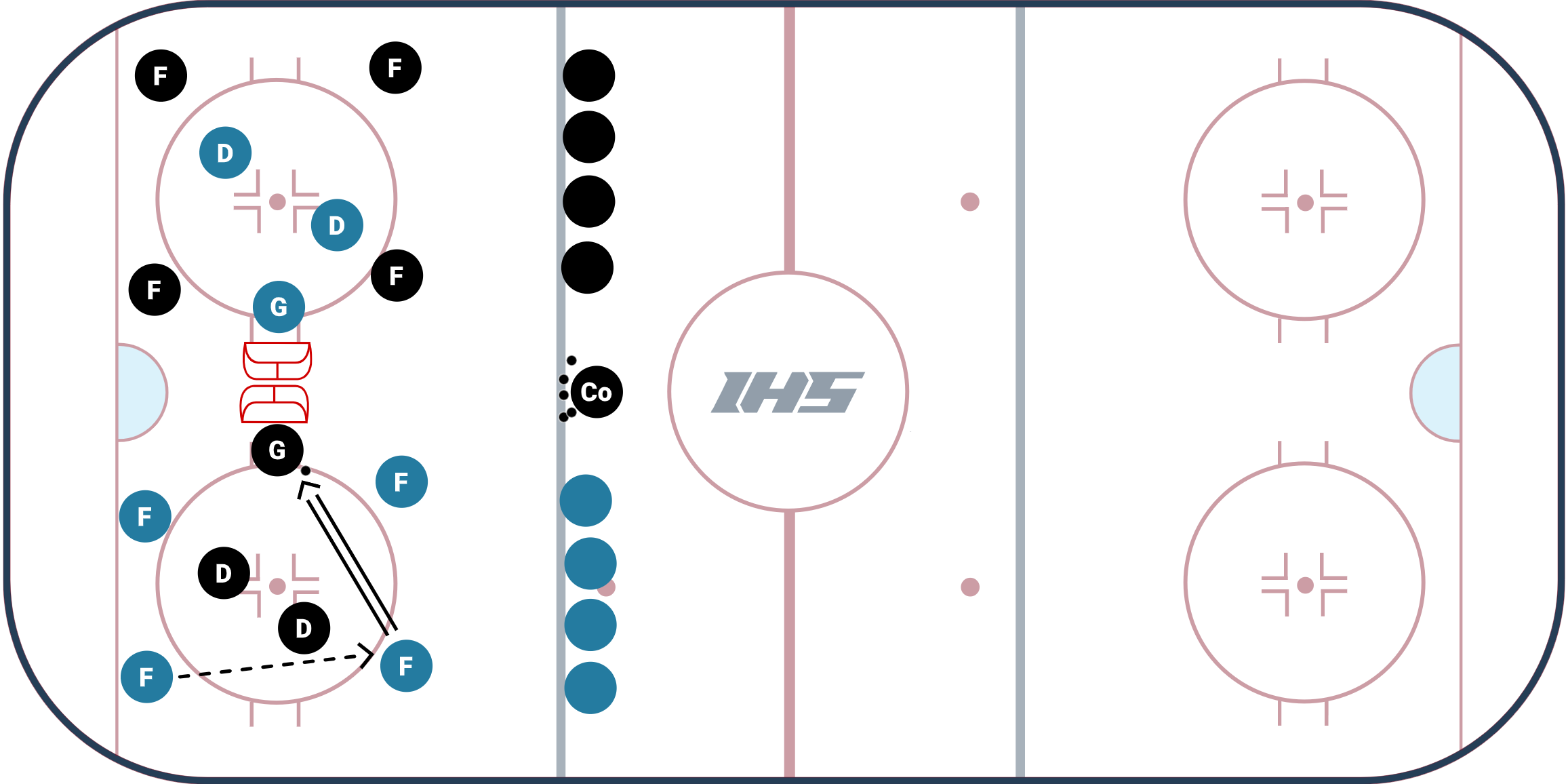
Picket Fences Game (2 vs. 2 or 3 vs. 3)
Picket Fences is a great small area hockey game that can be setup as a 2 vs. 2 or 3 vs. 3 game. The offensive team gets 2 points for scoring a goal and the defensive team gets 1 point by skating the puck between the tires.
Setup:
- Teams are set up in one of the offensive zones in line with Dots.
- Players help keep the puck in play if it comes over towards the line of players
- Net is set up in the Blue Paint (per usual)
- There are two cones 10-15 feet apart just above the tops of the circles in the zone
- Coaches set up just outside the Blue Line with a pile of pucks
Game:
Objective: Play a Game up to a certain Number (1 point for the Defensive Team skating the puck between the tires & 2 points for the Offensive Team when they score)
- When the whistle blows, three players in White (Offensive) get a puck from coach while three players in Red (Defensive) being to defend
- The team in White attempts to score while the Team in Red attempts to steal the puck & skate it between the tires
- The coach allows the players to compete for 20-30 seconds
- There is NO change of possession (White is offense the entire shift)
- When the next whistle blows, three new players enter from the White and Red team
- Now, Red is on Offense and White is on Defense
- Coach can give a new puck to the Offensive Team if:
- If the goalie covers the puck
- If the puck goes out of play
- A goal is scored
- The defensive team skates the puck between the tires
Principles:
The brilliance of this game is both teams are attempting to ‘score’ while one attacks the goalie & one aims for possession to skate the puck between the tires.
The game incorporates:
- Defending 3v3 (in a condensed space)
- Once the Defenders gain possession of the puck, they must thinking ‘offensively’ to skate/get open to score a Goal (skate puck between tires)
- Communication with other teammates is essential so each defender can operate in a ‘man on man’ scenario
- Attacking 3v3 (in a condensed space)
- The offensive players are can either challenge a defender 1v1 with the puck or try to isolate and create a 2v1 on a defender
- Player without the puck must work to get open, drive net or create space for teammates
- Must find a way to create space & opportunities to get off a quality shot with pressure
- ‘Play after the Play’ – anticipate loose puck/rebounds and regain possession for more offensive zone time with the puck
- Players must constantly talk & perceive the ever changing environment to solve problems as they happen (both offensively & defensively)
- The offensive players are can either challenge a defender 1v1 with the puck or try to isolate and create a 2v1 on a defender
Related Game / Variation
The picket fences 3 vs 3 uses the full zone and incorporates 2 gates. This way the defenders can use deception or are forced to use another option in order to carry the puck through the gates.
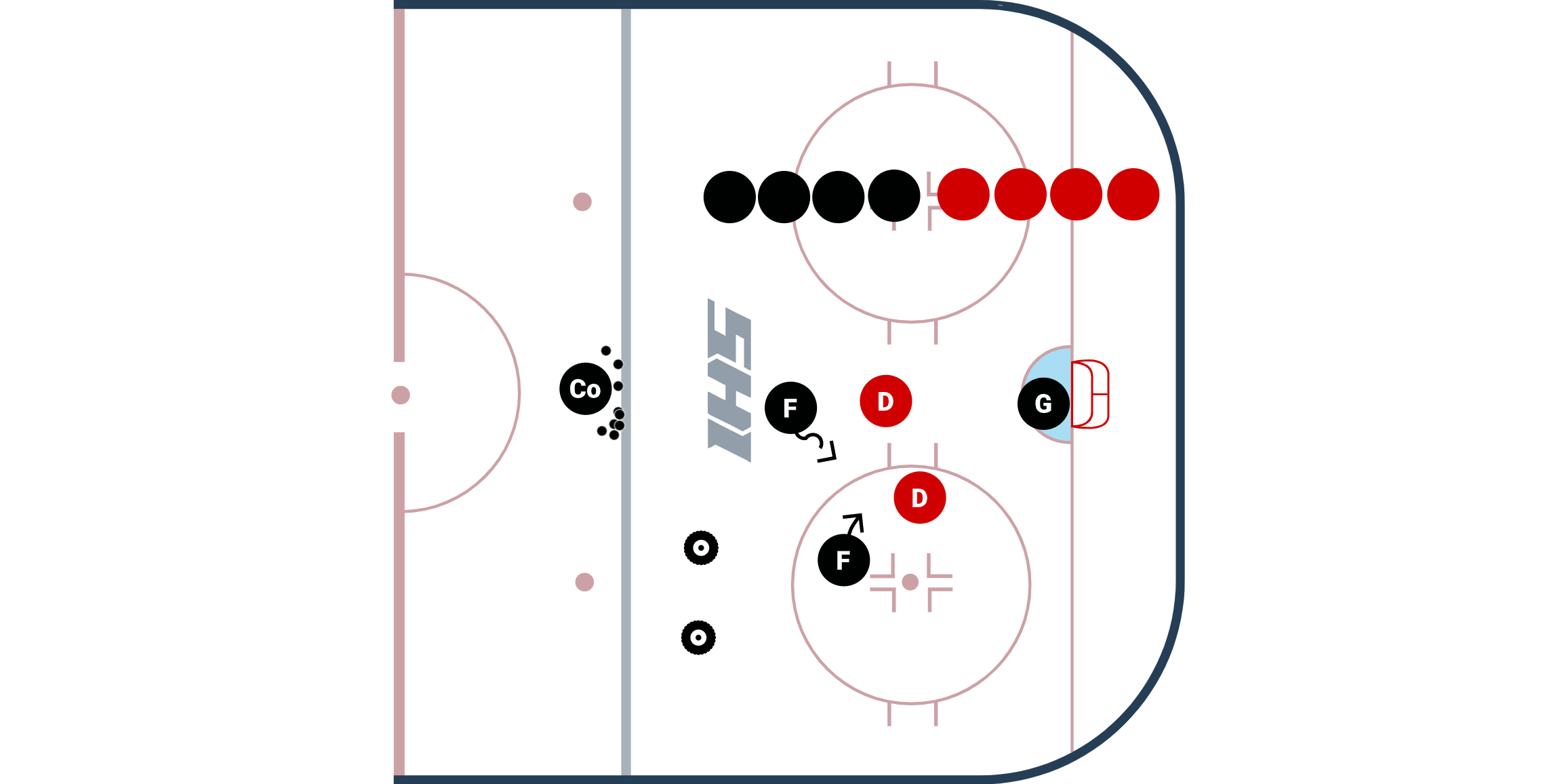
6 vs. 3 Alley Game
The 6 vs. 3 Valley Game from Coach Steve Wiedler is used as a power play & penalty kill drill that has many important concepts that players can work on.
Game Setup
- 3 defenders in the "Alley" that work to disrupt passing
- 6 Offensive players that are outside of the "Alley" that work to score a goal. The offensive players must pass the puck across the "Alley" at least once before they are allowed to shoot.
Defensive Coaching Concepts
- Angling: eliminate time and space with your body and stick.
- Disrupt Passing Lanes: identify passing lanes, close the lanes with your stick and when you are close, stick on puck!
- Keep Puck On One Side: work to keep the puck on one side of the ice.
Offensive Coaching Concepts
- Head up: pay attention to where your teammates are and where the defenders are.
- Use Deception: Look one way to get the defenders to move their stick and pass another way.
- Get Open: if you do not have the puck, work to get open and out of a blocked lane.
Variations
- Can set this up to be a 6 vs. 3 , 6 vs. 2 (view example), or a 4 vs. 2.
- Can require players to pass over the "Alley" 1, 2 or 3 times before they shoot.
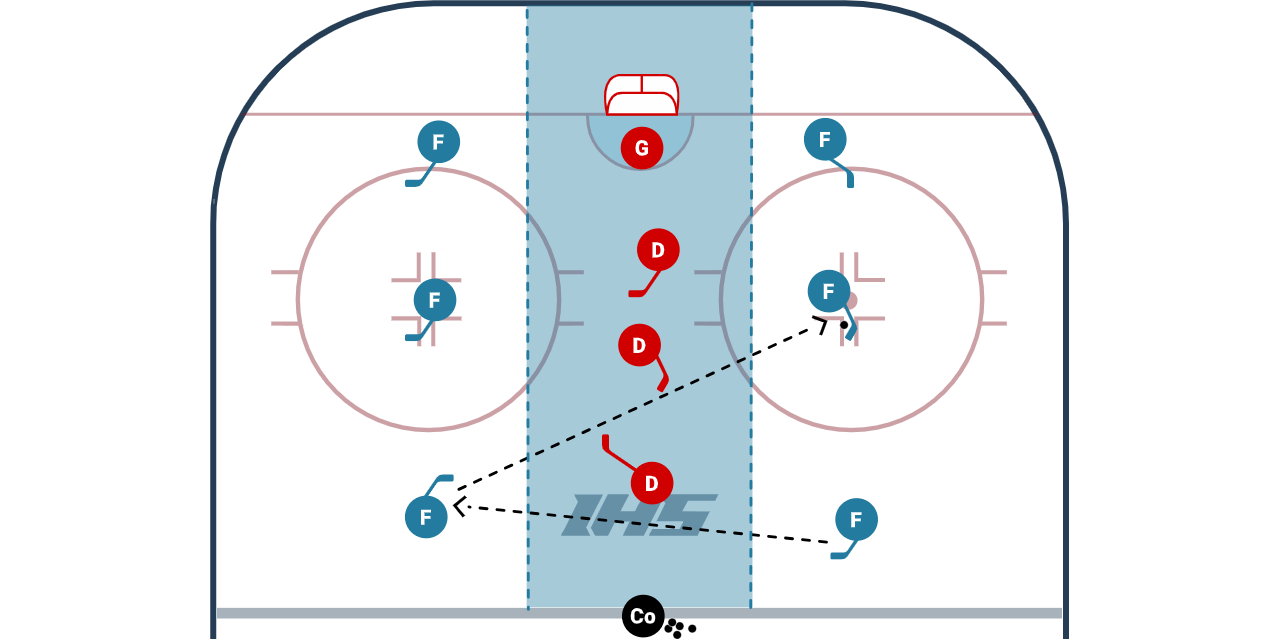
Levels 3 vs 3 Small Area Game
A fun small area game to keep players, goalies and coaches on their toes! The video clip is of The Buffalo Sabres's playing Levels during their development camp. As time went on and the players got more comfortable with the game, you could tell they absolutely loved it. To do well in this game it is important that teams transition quickly, communicate well, create space on offense and takeaway space on defense.
Game Setup
- 2 nets and 2 goalies. 1 net is flipped the other way.
- 3 vs 3 with coaches that act as "bumpers." You can swap the coaches with players to get more players involved.
- For the start of the game, the coach dumps the puck in for 50/50 puck.
- Whichever team gets to the puck and passes to a coach is on offense and is allowed to shoot on both nets. The coach or "bumper" must always pass back to the team that passed them the puck.
- During the game, if the defense gets the puck, they need to transition by passing to a coach first before they can play offense and attack.
- The game presented lots of unique situations and everyone needed to be paying attention.
Please note: Having a net facing the opposite way presents fun, unique opportunities in the game, but it also has the opportunity for players to get hit with shots if someone misses the net. That is one reason why this activity is better for older age groups. If this is a concern for you as a coach, you can keep the exact same rules but flip the nets so they are both facing the "normal" way.
Variations
- You can also swap out the two coaches that are bumpers and use players.
- This can be 2 vs 2 in a smaller area of ice.
- You can flip nets so they are both facing backward or facing the normal way but keep the same rules.
- You can add additional bumpers. Or you can allow all players that are waiting their turn in line to be bumpers so everyone is paying attention and involved!
Related Content
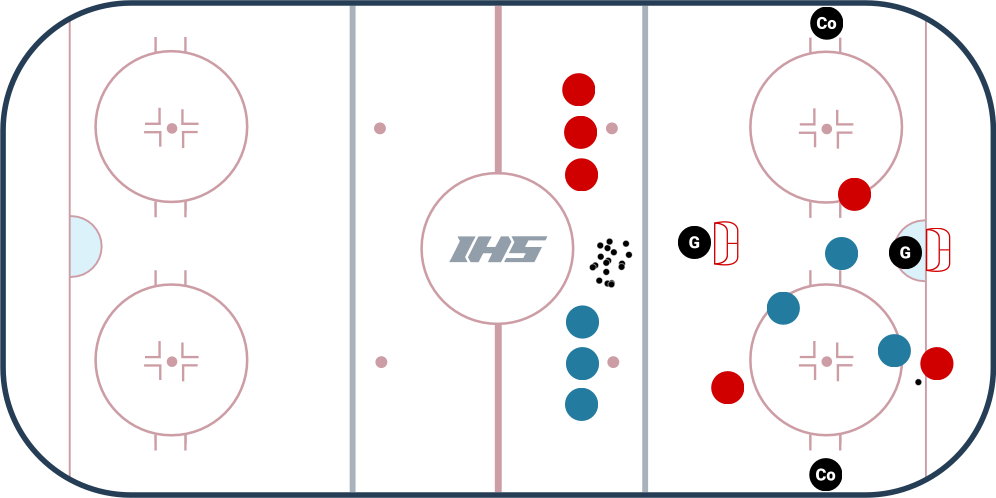
Full-Ice Scrimmage (5 v 5, or 4 v 4)
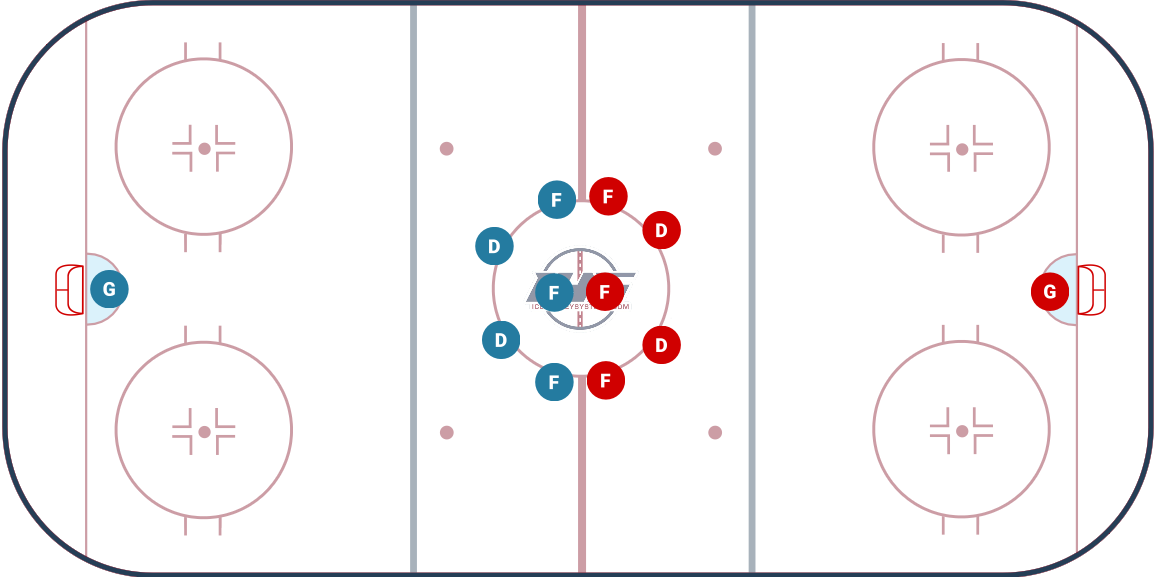
Finish Battle Day with a 5 v 5 or 4 v 4 Scrimmage. Coaches can also set this up to be a 3 v 3 Cross-Ice Scrimmage if players are tired.
Coaches can award 2 points for specific skills the team is working on. For example - 2 points for a goal that is scored on a one timer. 1 point for a normal goal.
Below we have links of resources you can use to create your own Battle Day.
